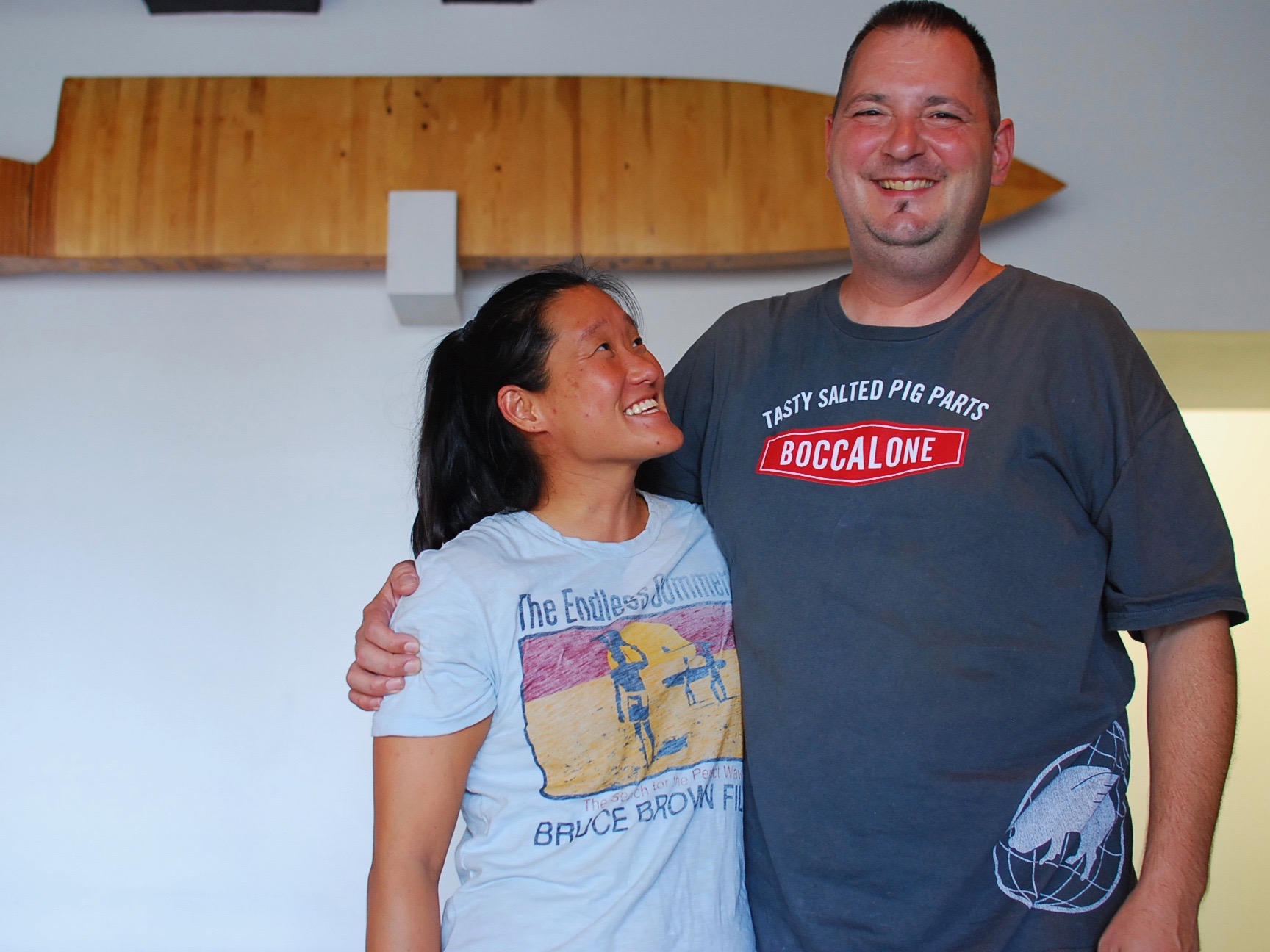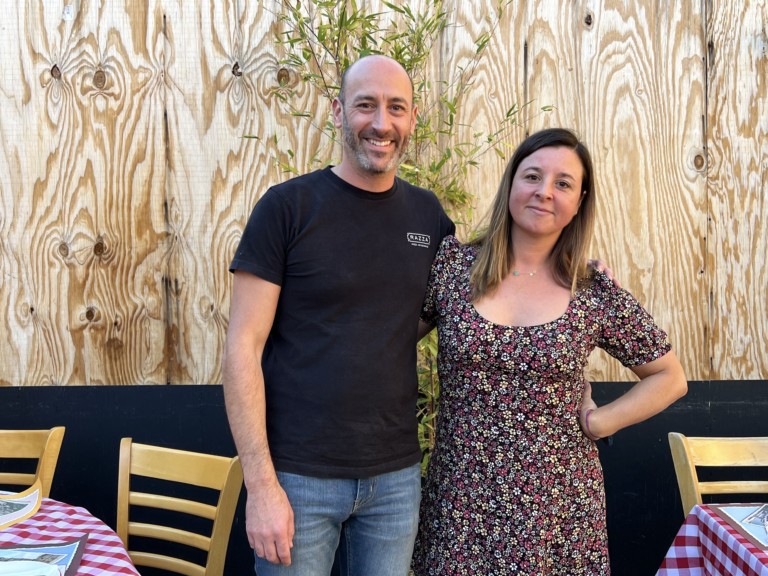Western Culinary Institute brought Rochester native Robert McGee to the West Coast, and it was in Portland that he became a believer in whole animal butchery and cooking. He started at Higgins, helmed the kitchen at Slow Bar, and eventually continued west to Honolulu with surfer wife Erica. McGee worked in a series of high-profile kitchens before setting up The Whole Ox Deli in Kakaʼako. We stopped by the Ox between lunch and dinner service and McGee shared several culinary insights.
What was [the space] before?
It was a lot of places, some kind of seedy. Right before we came in, it was a Thai restaurant…This building is really big. We smalled it down…For our business model, being a butcher shop and a deli, it had to be slightly closer quarters. Picnic tables are very important to what we’re doing, to be very family and community, sitting next to strangers kind of idea, sort of forcing the issue of people getting to know people…We’re very not formal here. We do honest food that’s not foo foo. It’s all about flavors. They may be classically based French techniques, but it’s very casual. It comes in a bowl and we hope you like it.
What brought you out to Hawaii?
It’s Hawaii…Erica surfs and we lived in Portland for the longest time, and she would go four, five days a week and would go early in the morning before work, strap on a three, four-millimeter suit and surf. When we sold our house, we were looking for the next place and after 10 years, she said, “It’s Hawaii, because I want to wear a bikini and surf.” It just seemed to make sense. And I had no intention of enjoying myself here. I don’t like hot weather. I revolted, but I was here a week and we knew. It didn’t take long to understand we wanted to settle here, for sure. I certainly did not expect to own a restaurant when I moved to Hawaii.
Really?
Yeah, it was not my intention to grow roots here, but like I say, I was here a week, and this is heaven, even with the heat.
This kind of butchery-driven cuisine is becoming more prevalent in Portland right now.
Yeah. What we do on the mainland is a dime a dozen. If there isn’t, there should be one on every corner. Everybody has a local butcher they go to. Portland, Chicago, L.A., New York, that’s their thing. Everybody gets back to having a local butcher, using meat from within 100 miles, 200 miles. It’s a unique situation here because we’re on an island. Farmer John doesn’t drive the cow over to you after he’s been processed. We have to go through a middle person. Some stuff you can get direct, but in general you go through a purveyor, but it’s a purveyor of local meats. We get our beef from Kauai, Andrade family ranch. It’s on the Westside, it’s grass fed, it’s grass finished. The Robinson Family Reserve Ranch, we’re the only ones that get beef from them. But it doesn’t come directly from them. Maybe some day it will. PIBA Meats brings it to us, but they set up the account for us. They service that ranch just for us. Glenn and Amy Shinsato could bring pigs directly to us, but it’s easier for them to use PIBA Meats as well. On Maui, we get direct from a freight forward company. Malama Farm we get more or less direct, but freight forward. It’s a different game here. It’s so unique. Some of the best stuff I might get jealous about is on the Big Island, and it takes me three days to get it, so is it worth it to get three-day-old produce when I can get fresh produce here? It’s an island. It is what it is.
How much did you have to adapt your approach to Hawaii?
Not much. A cow’s still a cow when you get it. Because we use only grass fed, grass finished stuff, a cow is anatomically and structurally the same, but the fat content’s different. The lean versus fat content is a lot different, but it’s still a cow. A pig’s still a pig. You don’t have to adapt that much. There are things that you can’t get here that you can get in cold weather climates. You can’t get turnips…I’m not going to put rutabaga on the menu because it doesn’t make sense here. At the same time, you can get really, really good stuff that you can’t get there. You can’t put mangoes on a menu in western New York. Even here, there’s a mango season…Everybody says, everything’s in season all year-round here because of this wonderful climate. In truth, tomatoes are at their best right about a week ago, even though they’re grown all year round. Truly outside tomatoes, or cucumbers, or chile peppers, a week ago they’re at their best.
Have you owned a restaurant before?
I never owned a restaurant before this place, but we definitely had to do this here. When the opportunity came and the building looked like it could support it, and the neighborhood seemed forward thinking, that was the impetus for the whole thing. It definitely needed to be done here, and we kind of had an opportunity to do it. We thought we could make it happen. My past experience has led me to this, so it made sense. I really wanted to flip burgers on the beach for a year and get the heck out of Hawaii. That was my view before we moved here. It’s hard to say no once you get here.
What’s your favorite part of owning a restaurant, now that you do?
The bills…No, the hours…No, the truth is it’s the same as when you’re a chef, or no matter what you’re doing, it’s smiles. Or when people get it. We do something unique here, and we really had hesitations about whether – we live in a Costco economy – so bringing in local cows, taking them in whole and butchering – it’s a pain in the neck. Everything we do here, whether it be a sandwich or a burger or a steak, you would be hard-pressed to find anywhere on this island that works harder to get a burger on a plate. So when gets it, when somebody digs what they eat, that does it every time. You’re a chef. People like your food, you’re doing okay. If you could get paid every once in awhile, that’d be nice too.
Do you change the menu much?
We have this framework that we work on, so yes, but the bones of the menu are based on animal utilization. I have to use the middle section of a pig, so that’s our porchetta. I always have to have something smoked, because I need to use the hind quarter and the fore quarter of the pig. Roast beef, we use the hind quarter from the beef. Most of the fore quarter gets ground into burgers. So yes, it’s a framework that we work around. My eggs Benedict, the proteins change based on what we can smoke or cure or brine, or something new we want to mess around with. If we’re long on beef neck, we have braised beef. If we’re long on pork should or have a big pig come in that we can get to grind, we turn that into sausage. I’d like to say it’s a very sustainable menu, but sustainable and restaurant don’t really go hand in hand. What it is, is complete utilization. We use everything, from tongues to hooves, if you at my restaurant, you’re eating everything one way or another.
Would you consider yourself a butcher or a chef first, or is there even a distinction?
INTERVIEW CONTINUED ON THE NEXT PAGE









Leave a Comment